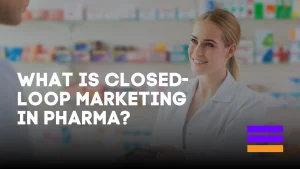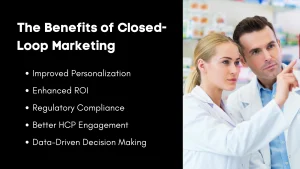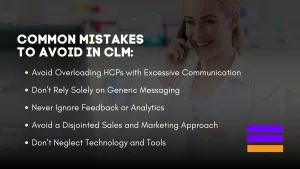Understanding Closed-Loop Marketing in the Pharmaceutical Industry

Pharmaceutical marketing is changing significantly. Data-driven tactics that prioritize accuracy and personalization are replacing conventional techniques, which are often dependent on large, non-specific outreach methods. New tools and technologies are helping companies communicate more effectively with HCPs and patients as the sector transforms.
Closed Loop Marketing is one such creative approach directing front stage. Pharma companies may maximize their marketing by employing real-time data and analytics to establish meaningful, focused engagements. The idea of closed-loop marketing in pharma will be discussed in this post in addition to its use and why it is turning into an important tool for the marketer.
What is Closed Loop Marketing?
Closed-loop marketing uses marketing and sales data to better future strategies. It functions as an integrated system in which every interaction — from email to digital platforms to in-person meetings — offers useful information. Analysis refines and optimizes marketing efforts. Applied in the pharmaceutical industry, CLM emphasizes:
- Gathering HCP and customer data for action.
- Crafting and delivering customized messaging using analytics.
- Creating a data-driven feedback loop to boost engagement and campaign performance.
Consider it as a system whereby nothing is left for guesswork. Every action informs the next, making marketing more effective and efficient.
How Closed-Loop Marketing Works in Pharma
Using Contract Lifecycle Management in the pharmaceutical industry requires various linked and important actions. These procedures include evaluating contract management processes, finding ways to enhance them, and choosing a closed loop marketing pharma solution that meets industry regulatory and compliance criteria. To guarantee effectiveness and compliance with regulatory standards, proper implementation also calls for integration with current systems, extensive staff training, and continuous monitoring.
1. Data Collection
Data points come from every brand-target audience interaction. This could include:
- Participation of HCP during sales trips.
- Feedback on email marketing and webinars.
- Website activity, social media contacts, or survey responses.
Pharma marketers use CRM and customer relationship management software to centralize diversified touchpoint data.
2. Analysis & Insights
Artificial intelligence-driven analytics looks at the gathered data to find preferences, trends, and behaviors. If an HCP engages more with diabetes management education, this can influence future marketing campaigns.
3. Content Optimization
The analysis helps create customized messaging adjusted for HCP tastes. Clinical reports, case studies, and treatment instructions are only shared if they are useful.
4. The Feedback Loop
At last, one considers the campaign’s real-time performance. Email open rates, click-through rates, and prescription upticks help sales and marketing teams improve their campaigns.
Example in Action
Imagine a pharmaceutical business pushing a breakthrough heart therapy. The company collects data from HCP email interaction using CLM, analyzes it to find people interested in trial efficacy, and then sends individualized white papers on the topic. Later conversations refine the outreach strategy.

Key Components of a Successful Closed-Loop Marketing Strategy
Pharmaceutical companies must include these aspects in their closed loop marketing strategies to enhance its impact:
1. Omnichannel Integration
Engagement has to happen on several, linked channels: email, social media, webinars, face-to-face meetings, and others. These channels should integrate seamlessly to give healthcare professionals a uniform experience. Consistent presence across various touchpoints guarantees that HCPs get valuable, pertinent content and support whenever or how they interact with the brand. Brands can strengthen relationships and trust by meeting customers where they are.
2. AI & Predictive Analytics
Modern closed-loop marketing (CLM) relies on machine learning algorithms. By use of previous behavior analysis, these instruments may predict HCP wants and preferences, therefore enabling marketers to provide focused, high-value content at just the correct moment. Predictive analytics can optimize outreach by identifying when HCPs are most likely to connect with a campaign or offering. This degree of customizing not only increases involvement but also enhances the general success of the strategy.
3. CRM & Marketing Automation
Essential tools for organizing client data and planning flawless, customized, pharma closed loop marketing include platforms like Veeva, Salesforce, or HubSpot. These tools let firms track interactions, engagement metrics, and relationship management. With these systems, marketers may create processes and automate tedious jobs, therefore guaranteeing that no opportunity slips through the cracks. Centralized data improves segmentation and marketing to HCPs’ requirements.
4. Sales & Marketing Alignment
Sales and marketing must work together for CLM success. Open communication, shared data, and clear roles guarantee that marketing and sales teams are working toward the same goals. When sales and marketing are aligned, they can deliver consistent messaging and create meaningful, coordinated interactions with HCPs. This closed-loop marketing cycle not only improves efficiency but also ensures that every touchpoint adds value, ultimately driving better outcomes for both the brand and the HCPs. Regular feedback loops between the two teams also help refine strategies and address challenges proactively.
Guidelines for Effective Closed-Loop Marketing
Best Practices
- Understand Your Audience Thoroughly: Segment your audience using a thorough study. Understanding healthcare professionals’ needs, interests, and behaviors helps you adapt communication and deliver excellent content.
- Leverage Data-Driven Insights: Use data analytics to measure engagement, campaign performance, and actionable insights. Data analysis helps you optimize strategies and keep closed loop marketing effective by revealing what works and what doesn’t.
- Invest in Training for Sales and Marketing Teams: Give your teams the CL marketing skills they need. Platform, tool, and strategy training helps your teams do their duties consistently and professionally.
- Personalize Content and Approach: Always provide tailored experiences. Personalized messaging that resonates with HCPs’ needs builds enduring relationships and boosts consumer satisfaction and loyalty.
- Ensure Compliance with Regulations: Keep current with GDPR and HIPAA obligations. Compliance with regulations protects HCPs’ rights, your organization’s reputation, and ethical practices.
Common Mistakes to Avoid
- Sending too many emails, messages, or updates might disengage your audience. Instead, prioritize quality over quantity and communicate at a rate that respects their time.
- Using generic content can alienate your audience. HCPs prefer targeted communication that meets their concerns or interests.
- Your plan may suffer if you ignore feedback or analytics. Continuous improvement is necessary for relevance and success.
- Shared goals and data should help sales and marketing teams work together. A fragmented approach can cause communication gaps and a confused audience experience.
- Failure to use new tools or technologies may harm your CL marketing approach. Keep up with innovations for efficiency, engagement, and competitive edge.
Challenges and Considerations in Implementing CLM
Transitioning to closed loop marketing is difficult. The main obstacles are:
1. Data Privacy & Compliance
Pharmacies must follow GDPR and HIPAA data privacy laws to handle sensitive patient and customer data. Noncompliance can lead to heavy fines and damaged reputations that could affect shareholder and client trust. Compliance requires strong security and auditing protocols.
2. Integration with Legacy Systems
Many pharmaceutical businesses use antiquated systems that cannot interact with contemporary CLM solutions. Operation delays might result from data silos and inefficiencies. Careful system evaluation and middleware or APIs to bridge old and new technologies are needed to overcome this difficulty.
3. Adoption by Sales & Marketing Teams
Selling and marketing teams must want to utilize a new CLM technology to make it work. Success depends on team members being well-trained and comfortable with technology. Without effective onboarding and support, adoption rates may drop, limiting new tool benefits. User-friendly interfaces, hands-on training, and technical support may promote adoption.
4. Resistance to Change
Automation and data-driven decision-making sometimes face internal resistance, especially in traditional businesses. Job interruptions and new system effectiveness may worry employees. Clear communication of advantages, stakeholder involvement, and phased implementation to ease the transition are needed to overcome this.
These challenges demand strategy, staff training, and a trusted technology partner to deliver customized solutions and ongoing support.
Steps to Implement Closed-Loop Marketing in Your Pharma Business
A step-by-step approach to CLM implementation in your company:
- Identify Key Data Sources & Channels: Determine your data sources, such as CRM, social, and sales reports.
- Implement a CRM & Analytics System: Choose solutions that meet your team’s demands and offer robust reporting.
- Align Marketing & Sales Teams: Communicate and discuss goals to unite teams.
- Create Personalized Content for HCPs: Use data to create effective messaging.
- Continuously Measure & Optimize: Utilize performance metrics to improve your strategy and results.
Why CLM is the Future of Pharma Marketing
Closed loop marketing marks a paradigm change in pharmaceutical company interactions with patients and healthcare providers. This strategy collects data, analyzes it, and refines tactics based on insights to create a continuous improvement cycle. Companies that give personalizing top priority will be able to provide customized materials and solutions that really appeal to their target market. Organizations may track campaign performance and optimize with rich analytics. Feedback-driven campaigns also guarantee that marketing initiatives remain relevant and successful, changing in real time to satisfy the changing needs of HCPs and consumers. These aspects enable pharmaceutical companies to sell more efficiently, engagingly, and successfully than ever before.
Your company should start planning if it has not yet made the change. CLM is about excelling in a competitive market, not just keeping up.



